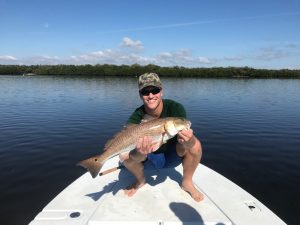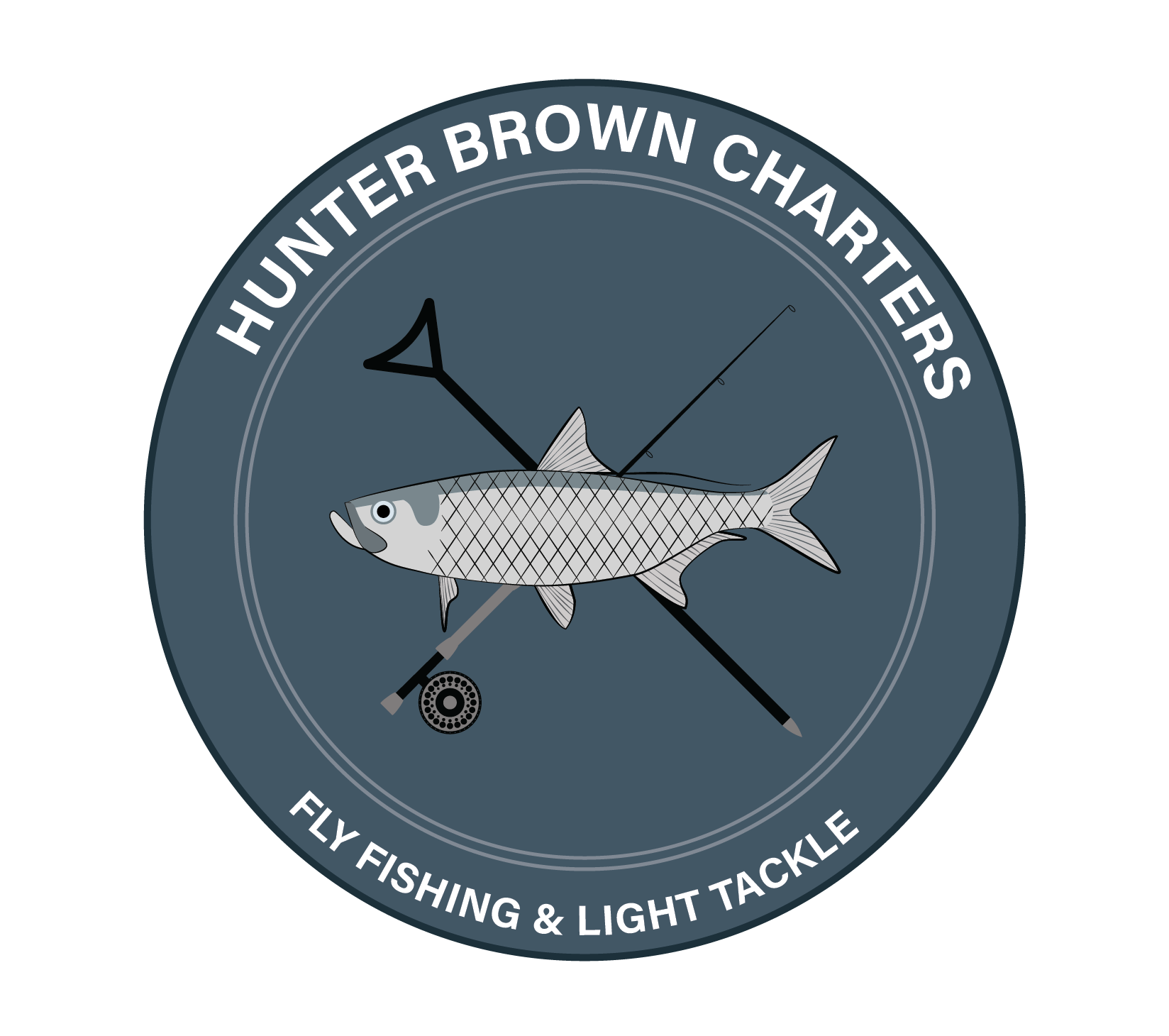Tailing redfish provide one of the most exciting visual displays in backcountry fishing, it is the anglers equivalent to a fanned out gobbler during spring turkey season. The angler is able to spot the feeding fish that they want to target, stalk the fish, and finally watch it react to their presentation of the bait or lure. Tailing fish are exciting for anglers because there is no question of where they are of whether or not they will bite. If you put a bait in front of them with a decent presentation they will almost always eat. This brief article will outline a method that I often use for catching tailing redfish in shallow water. This method can be applied to spin fishing with live bait or lures as well as fly fishing.

Here’s a nice slot redfish caught in about a foot of water using the method described in this article.
Before we talk about catching tailing redfish we must first understand this behavior. Tailing refers to the behavior of a redfish feeding in shallow water, where their tails stick out above the surface of the water. Redfish eat mostly small crustaceans and other animals that live in the seagrass. When the redfish is rooting through the grass in search of these animals, tailing behavior can often be observed. Redfish will not tail in deeper water because their tails will not reach the surface.
The first step to catching a tailing redfish is to locate likely areas and times where the fish will be tailing. Redfish in the Charlotte Harbor, Boca Grande area can be seen tailing throughout the year, however, the best action is often found in the cooler months. Early morning and before dark are often good times to find tailing fish, however, this behavior can be observed throughout the day. As discussed earlier, redfish can only be seen tailing in water that is less deep than they are long. For example, to see the tail of a 26 inch redfish in 25 inches of water, the fish would have to be feeding almost vertically. While tails will show up in water at these depths they often just poke out of the water briefly and go back down as the fish moves. In shallower water, around 12 to 18 inches in depth, the redfish tail will stay out of the water for much longer periods of time, which makes spotting and stalking them far easier. My favorite place to fish tailing reds are large even grass flats with few sand holes from depths of 8 to 18 inches of water. Grass flats with more sand holes will also have tailing fish, but the reds can be hard to see when they drop into the holes, on a flat with few holes, they stay visible for longer periods of time.
Once tailing fish have been located the next step is to maneuver your boat to them. Some people like to wade to tailing fish, however, I have found that approaching them in the right boat is much quieter and more effective. Trolling motors are not ideal for tailing fish although they can work. Trolling motors make noise in the water and do not run as shallow as tailing fish can go. While the newer trolling motors are better as far as noise, they are still much louder than a push pole. A push pole is a long (18-24 foot) carbon fiber, graphite, or fiberglass poll that is used to push the boat in shallow water. Push poles do not have to be a fancy purpose built tool; wooden dowels, PVC pipes, and bamboo can be just as effective. With one or two anglers on the bow of the boat and a guide on the poling platform or stern deck, you can sneak well within casting distance to a tailing fish. The guide on the stern uses the push pole to quietly push the boat in the direction of the fish. One thing to watch out for when approaching tailing fish with either a push pole or trolling motor is hull slap. Hull slap occurs when small wind waves make noise by splashing against the hull, this can be minimized with a well-designed boat or simply poling downwind. Also, very important is minimizing sudden movements that send pressure waves in the water. Livewells or bubblers on board that make noise, bilge pumps, or anything else that could make noise on the boat should be turned off or reduced to a minimum. If your boat is not designed for quiet poling or you are fishing solo, getting upwind of the tailing fish and drifting down on them can be very effective, you just have to make a good cast before they spook from the boat.
Now that we have covered how to find and approach tailing fish we will look at baits/lures and presentation. We already know that when a fish is tailing it is feeding with its head down deep in the grass. This behavior presents both opportunities and challenges to the angler. While it is easy to see and approach a tailing fish, it can be difficult to make a good presentation when its head is buried in the grass. The best way to ensure that the tailing redfish finds your bait, lure, or fly is to put it right in front of the fish’s nose. When looking at a tailing fish you can determine the direction that it is facing by how the tail is pointing. Just imagine what a redfish looks like out of the water and it is easy to guess where the rest of the fish is based on the visible tail. Additionally, the tail shows us the direction that the fish is moving. Once you have figured out where the fish is and where it is going you know where to put your bait. The ideal placement of a bait for a tailing fish is a few inched off of the fish’s nose. We can assume that the nose of the fish is 20 to 28 inches from the tail in most cases and the size of the tail often informs us as to how big the fish is. To put a bait right off the fish’s nose without spooking it I like to cast maybe 3 to 5 feet past the fish and drag my bait back to the fish. By casting past the fish you can also make small adjustments in the location of your bait as you retrieve it. Just point the rod tip to the left or right to adjust where your bait will go. If fishing a live shrimp or other live or dead bait, simply cast past the fish and drag your bait to the area right in front of its nose and let it sit. The redfish will grub through the grass, find the bait, and pick it up. If fishing an artificial lure on a spinning rod or throwing a fly, you will want to make small rapid twitches in front of the fish’s nose as you retrieve it. This is different from how you would normally work the artificial or fly because you have a very small window of presentation to the fish. DOA shrimp are a good choice for tailing redfish on spinning tackle and any small crustacean imitation is a good choice in flies.
Thank you for reading this article, I hope it will help you catch more tailing fish, please get in touch with me if you have any questions about anything written here.
To book a Boca Grande backcountry fishing charter for tailing redfish or any other species please give me a call at 941-735-1820 or visit HunterBrownCharters.com.
-Capt. Hunter Brown
